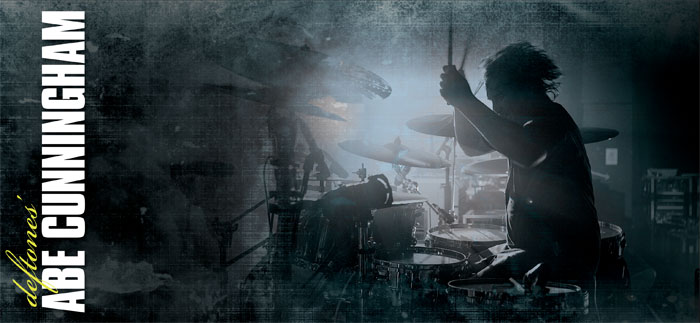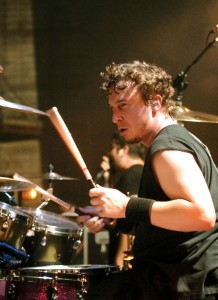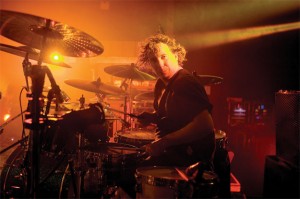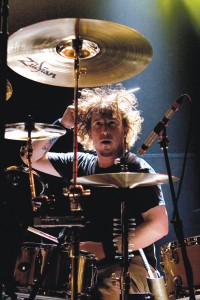Deftones’ Abe Cunningham

(from the July 2011 Issue of Modern Drummer Magazine)
Story by Ken Micallef • Photos by Ashley Maile
You play drums in a California alternative metal band whose members are constantly at war, and all the while you watch your albums consistently climb the charts. You tour the world, engaging in behavior you probably shouldn’t, enjoying extracurricular activities that many groups wear as a badge of honor. You love Stewart Copeland, Lars Ulrich, and Stevie Wonder, yet your band insists you bash an open 4/4 hi-hat much of the time. You settle for band peace over personal creativity. Then one day it all changes.
In 2008, Deftones were recording an album to be titled Eros, a work of atmospheric melodies, delirious Pro Tools soundscaping, experimental arrangements, and dark urges. Drummer Abe Cunningham, guitarist Stephen Carpenter, vocalist and guitarist Chino Moreno, keyboardist/ turntablist Frank Delgado, and bassist Chi Cheng were making real progress. This was no typical Deftones album—the band had matured since its previous release, Saturday Night Wrist, and was experiencing some of the best growth of its nineteen-year career. The guys were becoming friends again.
Then, on November 4 of that year, Cheng was critically injured in a car accident in Santa Clara, California. Deftones halted recording, stopped everything while waiting for their fallen comrade to return. But Cheng’s coma never lifted; the bassist never regained consciousness. Deftones put the wraps on Eros and took a long, well-deserved break. Slowly, tentatively, the band reconvened in the studio to make music, to talk, to pray for Chi. Joined by former Quicksand bassist and friend Sergio Vega and producer Nick Raskulinecz, the group recorded Diamond Eyes. In doing so Deftones found a new lease on their life, their friendship, and their band. Advertisement
Traveling in Germany on a recent global tour, Cunningham spoke with MD about life after Cheng’s accident, the aborted Eros album, and Deftones’ recent return to form.
MD: What’s the latest on Chi?
Abe: He’s making progress, but it’s extremely slow. He’s still unable to communicate, which is the worst situation I can imagine someone being in. We go to see him and he looks at us, but there’s a blank stare. I think he’s aware of what’s going on, but he’s not able to verbalize it. There’s all kinds of love coming from around the world, but it’s difficult when Chi needs funding. He’s not getting it from his insurance; they don’t cover everything he needs. Here we are more than two years later, and I’m just waiting for my brother to return.
MD: How would you compare Eros with Diamond Eyes?
Abe: It’s more experimental and spacey. Our past few records were extremely difficult to make. We made things hard on ourselves.
On Eros we really focused on being friends again. We were like a dirty cymbal; we needed some Brasso and elbow grease to bring out that shine again.
 MD: How did the band finally decide to move forward?
MD: How did the band finally decide to move forward?
Abe: We took a couple months off to figure some things out. Then we decided to go back in our rehearsal spot and bash it out. We just needed to get back together and play some music. That was very cathartic. We had a show booked, and that’s when Sergio came into the fold. He’d subbed for Chi before. We were big fans of his old band, Quicksand. So he was the only person we had in mind. We started jamming, and after two days we’d written a couple songs, including “Royal,” which ended up on the album. Then we never looked back.
MD: What’s the major difference between Chi’s and Sergio’s time feel?
Abe: We were seriously influenced by Quicksand, so it was a natural, easy fit. Chi was a finger player, but Sergio plays with a pick, so that tightened things up a lot. Chi was also more behind the beat, which was his trademark.
Advertisement
Sergio had a lot of material to learn too. He made us step up on a lot of levels. He made us pay attention to our older songs, and that brought us all together as a band.
MD: Producer Nick Raskulinecz also helped you free up your drumming for Diamond Eyes, right?
Abe: The recording process was a breeze. Nick was always air drumming around the studio with sticks. We called him “Man Who Walks With Stick.” We would just jam. In the past we thought we could just sit in the studio and write for months. But that didn’t always work and was very expensive. Nick had us set up eight-hour days. We had a schedule. He’d be behind me sometimes—it was driving me nuts! But I’d look back and he’d be grinning. That was freeing. He let me be me. He would record every day during preproduction and take the tracks home, so he’d have eight hours of us jamming. The next day he would point out parts, and we’d get down to it.
MD: And the band recorded to a click?
Abe: In the past when we weren’t speaking to each other, like on Saturday Night Wrist, someone would just lay something down with a click. That was the peak of our hatred for one another. This time we were a band again, so we tracked to a click and used tempo maps, but without piecing things together. We’re a band—we can play.
MD: How have your drum parts changed now that you’re back on the road?
Abe: I believe that you should be allowed to expand your parts, but our guitarist Stephen is of the mind that it must be exactly like the record. This has been our battle for years. Signature fills need to be there, but there’s always room for growth. My parts have stayed pretty much the same, though the songs do take life after they’ve been recorded.
Advertisement
MD: Has anything changed?
Abe: Really just getting the body back after being off the road for a couple years. Getting my calluses back and losing the gut from sitting at home. We’re leading a healthier lifestyle now. Better food, nice wine rather than vodka. I think my two hours of drumming a night is plenty of exercise; the other guys go to the gym every day. You can make things easier or make things harder on yourself. We’ve grown up.
MD: What’s your pre-gig warm-up?
Abe: We’re out with Coheed and Cambria. Now, that boy, Chris Pennie, has a pad with him at all times. That’s encouraging. I try to keep loose all day, but then I play basic rudiments on the pad for thirty minutes before the show. I play along to the music the crowd is hearing between bands. I jam out to that on the pad, keep the blood flowing, keep it loose.
MD: What are your living quarters like on the tour bus?
Abe: We each have our bunk and a wardrobe case. I’ve learned to travel light. I used to lug everything around the world and then never use it. We’ve got personal TVs, and we can slam the curtain shut if need be. The U.S. buses have front and back lounges, and the European double-deckers have three lounges, so it’s really nice. But no TVs in the European bunks!
Advertisement
MD: Do you sleep well on a tour bus?
Abe: I crave it when I’m home. But I’m a light sleeper and I sleep horribly on the bus. It’s a long drive sometimes, and usually when the bus pulls over for fuel or food, that’s when I crash. But I generally toss and turn all night long. I use earplugs so I don’t hear these fools snoring around me.

MD: On “Prince,” from Diamond Eyes, you play a Stewart Copeland–type groove, with ska figures on the hi-hat. What were you thinking there?
Abe: I am Copeland’s biggest fan; that’s just in me. I was trying to keep it going, keeping the hi-hats on the upbeats, which is very driving. Trying to keep it simple and fun. I keep that same part on the road; that song is very dialed in. I was listening to the album the other night and realized we’d really raised the tempo. So we brought it back down, addressed the exciting tempo leap. It’s a fun song to play.
MD: Was the tricky coordination between the bass drum and hi-hat in that song tough to master?
Abe: It was a kick in the ass at first, but like anything you do over and over, it gets a bit easier. You get the muscles firing right.
Advertisement
MD: Are we hearing mostly live drum takes on the album?
Abe: We go through and get a couple good passes, and we do a final free-for-all, not worrying about time or fills—just go for it. That’s always fun. You know you have the main part there, and then you just whip it out and see what you can snag. We go for feel, and hopefully we get that in a couple passes.
MD: Do you play at the same volume level live and in the studio?
Abe: I hit pretty hard, always have. But over the years I’ve learned that you can only hit a drum so hard. You need to let the mics do the work. Take a deep breath and ease back.
MD: Your drumming has a great sense of flow, which is not always the case
in metal.
Abe: It’s something I’m constantly working on. It’s just being more comfortable, and time and age play a part in that. Just being more at ease and knowing when to kick it in and when to lay back. I guess we’re a metal band, but I’m not a metal drummer. I can’t play double bass. I just come at it differently. I think of myself as a groove player, just trying to make it sound the best I can.
Advertisement
MD: The open hi-hat bash is a constant in your style. Is that to fill more space within the bar?
Abe: That’s funny. Getting back to Stephen, our guitarist, whenever I would tighten something up he’d say, “Let it sizzle!” These little battles have been going on for years. The open hi-hat thing developed from that. Maybe it helps fill up the music.
 MD: Where on the stick do you strike the open hi-hat?
MD: Where on the stick do you strike the open hi-hat?
Abe: With the shaft, the upper inch or two near the bead. And with my left hand I’m mostly playing rimshots on the snare. My main snare is pretty tight, but I have a secondary snare on the left, which has more of the big, fat, loose, ugly sound. That’s another battle I’ve had over the years with Stephen. He loves that cranked snare. But after a while it hurts to play and it drives me crazy. So I put the other snare up on the left to give myself some options. On some songs it’s the primary snare.
MD: Do you sit high or low in relation to the snare drum?
Abe: Pretty high. My first drumkit was my dad’s Ludwig set with a 24″ kick drum and an 8″ [deep] snare. I was seven when I began playing, so I had to sit high. Now I sit pretty much even, maybe a bit up from the snare but basically level. I like to be on top
of things.
Advertisement
MD: On “Risk,” are you playing with one hand or alternating hands on the hi-hat?
Abe: Alternating during the verses. Just for a quick flip on that. On that song we tracked it to a tempo map, and we raised the tempo one bpm in the verses. We did constant adjustments. Now we can just kick it up at will. In the past when we would kick it up we’d end up knocking it back a couple notches too, keeping it elastic.
There’s a song on the new album called “Beauty School,” and the choruses are way more laid back than the verses, where you’d think maybe we’d kick it up a couple bpm instead. We went through everything during the preparation for making the record. We had a lot of room to experiment. There are three or four different tempos in pretty much every song. Of course, live you get excited and things leap up a bit. I pay more attention to that now than I ever have. But just getting people on the same page, it’s not always easy. Sometimes people are in different places, and we’ve been together for twenty years. We’re always thinking about the next record.
MD: How do you stay amused on the road?
Abe: GarageBand is such a fun, cool way to write music. And the apps on the iPhone are great, just the simple mic for keeping ideas. It’s a great time now in terms of that kind of recording ease. At the same time, I like an old boom box that you put a towel over
to cut out the highs in the rehearsal room. I like to lay things down in GarageBand, and then I can communicate them to the band.
Advertisement
MD: How did you personally handle the tragedy that happened to Chi? How did you get back on track?
Abe: I have two sons, so I enjoyed spending time with them and going about normal things. I’ve spent so much time on the road, so being with the kids and watching them smile and seeing them be happy was incredibly gratifying and soothing all the way around. During the time of Chi’s accident it was nice to be grounded and normal. And there was always music around to help—Stevie Wonder. But my friend is not around now, and that kicks me in the rear end and makes me appreciate all the opportunities I have: health and happiness, family, the good things in life.
For those interested in contributing to a fund that has been set up for Chi Cheng, go to oneloveforchi.com. The site also updates Cheng’s situation.


